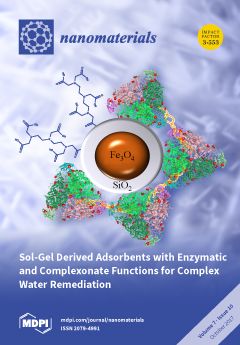Three non-metallic elements, sulfur, fluorine, and iodine, were used to dope the ultrathin two-dimensional TiO
2 nanosheets, which would regulate their electroanalytical properties toward heavy metal ions. Among these doped materials, fluorine-doped TiO
2 nanosheets shows the highest electrochemical sensitivity and a superior
[...] Read more.
Three non-metallic elements, sulfur, fluorine, and iodine, were used to dope the ultrathin two-dimensional TiO
2 nanosheets, which would regulate their electroanalytical properties toward heavy metal ions. Among these doped materials, fluorine-doped TiO
2 nanosheets shows the highest electrochemical sensitivity and a superior detection limit toward Pb(II) when the doping concentration is 10%. When compared with the bare TiO
2 nanosheets, the sensitivity increased by 102%, and the detection limit decreased by 36.4%. Through combining further electrochemical experiments and density-functional theory calculations, the enhanced electrochemical performance stemming from element doping was then investigated in detail. The theoretical calculation demonstrated that fluorine doping could greatly increase the adsorption energy of Pb(II) on the TiO
2 nanosheets and enhance their loading capacity. Both cyclic voltammetric and electrical impedance spectroscopy analysis indicated the enhanced electron transfer rate on the electrode modified by fluorine-doped TiO
2 nanosheets. Further measurement on the desorption performance showed the better stripping response of Pb(II) on the electrode with TiO
2 nanosheets after fluorine doping, which suggests that fluorine doping is beneficial for Pb(II) diffuse onto the electrode surface for the reduction and stripping reaction. Therefore, the element doping of two-dimensional TiO
2 nanosheets provides a facile method to extend the electronic materials toward detection of heavy metal ions in the environment.
Full article






